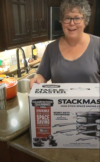When we started our journey in 2019, it was amid news of the super bloom in California’s desert. We recalled images of this Super Bloom as we planned our travels for this spring. Knowing that it was unlikely to have a super bloom two years in a row, didn’t mean that plants wouldn’t bloom. It just meant that there wouldn’t be the sheer numbers of flowers blooming all at once. With Needles, California, as the gateway to the Mojave National Preserve, we felt confident that our visit would at least coincide with flowers blooming in the desert. I’ve been saying for months that we hoped to see desert bloom while we were here.

It’s been a dry winter in the desert. And, as such, I started hoping for rain. I knew that without rain, the flowers wouldn’t be able to bloom at all. We arrived in Needles on Sunday, March 8th. It rained at least three days during the week that we arrived. Flowers blooming along the roads suggested that there was enough water.

We agreed that we would head to Mojave National Preserve on Saturday, March 14th. I read the information on the National Park System’s website about the Preserve, including the description on the homepage:
“Singing sand dunes, cinder cone volcanoes, Largest Joshua tree forest, and carpets of spring wildflowers are all found within this 1.6 million-acre park. A visit to its canyons, mountains, and mesas will reveal long-abandoned mines, homesteads, and rock-walled military outposts. Located between Los Angeles and Las Vegas, Mojave provides serenity and solitude from major metropolitan areas.”
There is also a dedicated page for Wildflower Viewing accessible from the NPS menu for “Plan Your Visit” while in the area. Surely, the sunshine would encourage the blooms, and flowers, like the yellow cups below, would be popping.

Somewhere I read that the Mojave National Preserve is the third largest within the National Park Service’s holdings. With 1.6 million acres, it is massive and it’s truly desert. We certainly wouldn’t be able to see it all, but we would be able to go for a nice drive and take time to get out and walk around at scenic overlooks like we’ve found at all of the other NPS places that we’ve visited. I reviewed maps and had some ideas about where we would spend our day before we left that morning.
With a full tank of gas and a packed lunch, the three of us, Brian, Skipper, and I, left for a day of adventuring in the desert. We entered the preserve off of the I-40 at Kelbaker Road to drive the first 23-mile leg to the Kelso Visitor’s Center, our first planned stop of the trip. There was a single turn-out with a small parking lot available about halfway into our drive where we stopped to look at the granite mountains.

Lots of traffic on the road had us feeling pressure to drive at least 55 miles per hour, the speed limit on this stretch of road. The vistas were beautiful but I wasn’t seeing much of anything blooming at all.
I hoped that our stop at the visitor’s center would provide some insight on how we should spend the rest of our day. I picked up the park guide and asked the ranger staffing the desk if he could help me. When I told him that we were hoping to see flowers, he looked at me and said something to the tune of “you should have gone to Death Valley or Joshua Tree. That’s where you go to see the desert bloom.” He continued to say that it’s very unusual to find flowers blooming in the preserve in any year, and if you’re so lucky to find them, it’s typically off of the main roads. When I mentioned the NPS website, he told me, “It’s called marketing. They want people to come here.”

Of course, I was disappointed about the flowers! He did help me select a route that would give us a little experience in the park off of the main road. Our route took us fourteen miles up Kelso Cima Road to Mojave Road. Here, we found ourselves a little ahead of the train we saw at the Visitor’s Center. Brian and I both took the opportunity to catch a few train pictures. It’s striking to see the colorful train cars against the backdrop of the mountains and desert.


From there we drove six miles (half paved and half dirt) to Black Canyon Road. Twenty miles of driving on this road (first half unpaved and the second half paved) wound us through Big Sagebrush Scrub, Blackbrush Scrub, Pinyon-Juniper Woodland, Joshua Tree Woodland. The views were outstanding although there weren’t many places to stop for pictures.

A turn to head south on Essex Road had us back to the I-40 towards home. The Mojave National Preserve is quite diverse from sand dunes to woodlands and from Joshua trees to junipers. The difference in terrain and plant life is remarkable. We saw only a small fraction of the preserve in our day there. And, while I was disappointed not to see the desert bloom, I now know where to go to see it. The Mojave National Preserve is worth going through simply to appreciate its beauty and the diversity of the vast land within it. And as it falls between the I-15 to the north and west and the I-40 to the south, there are ways to incorporate a drive through the preserve on your way through the area





2 Replies to “Mojave Desert Bloom”
Comments are closed.